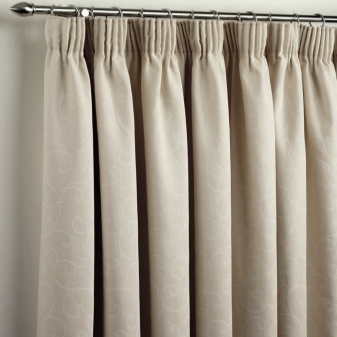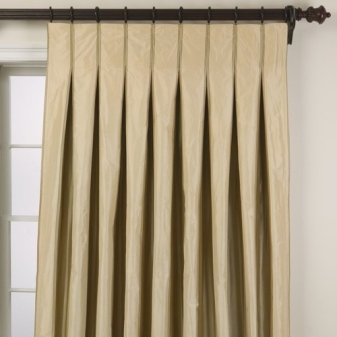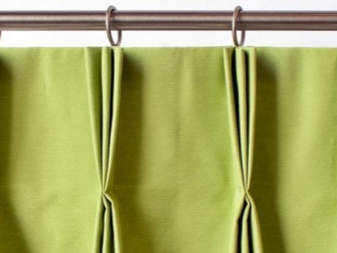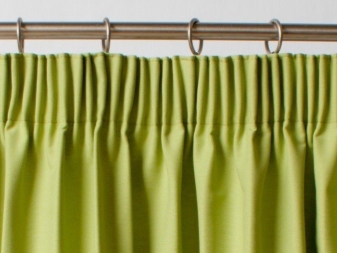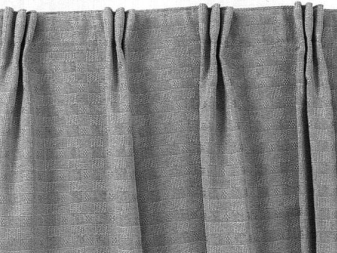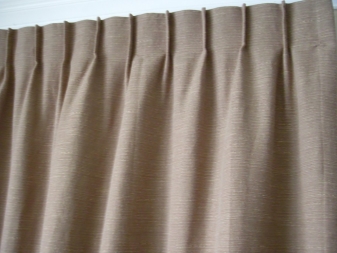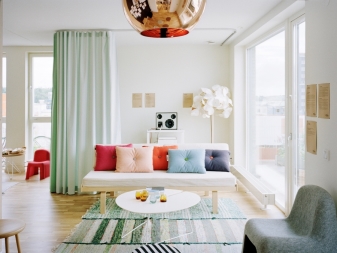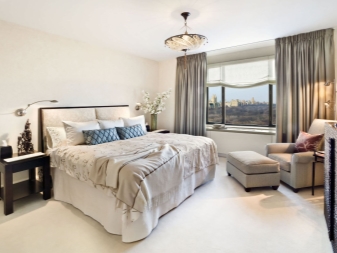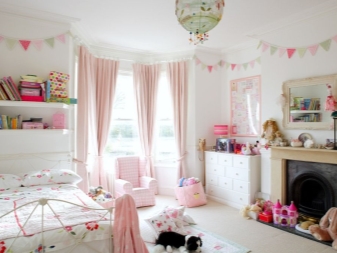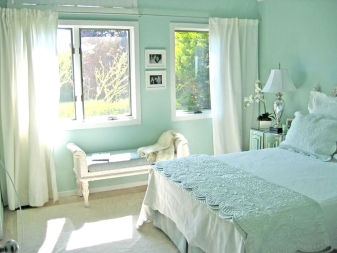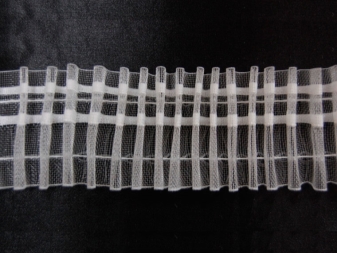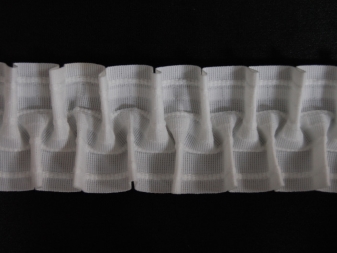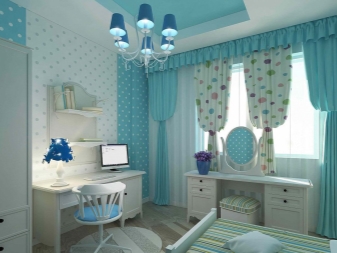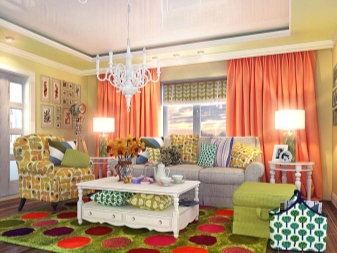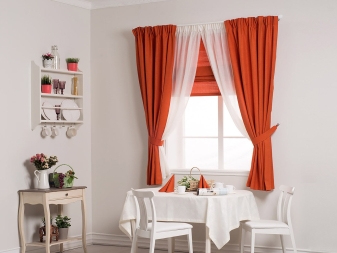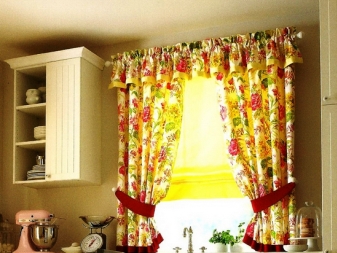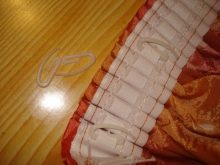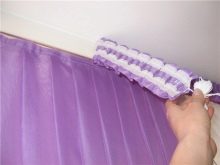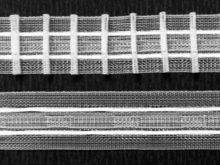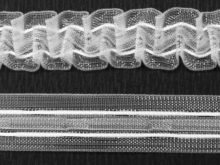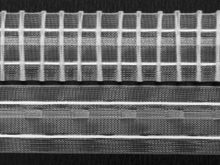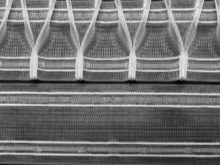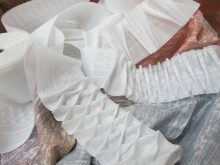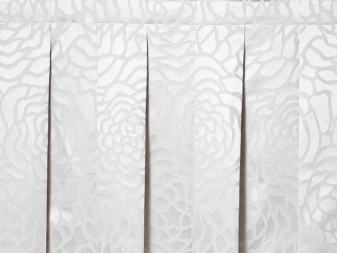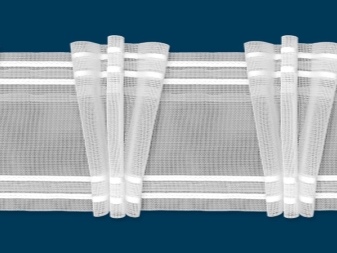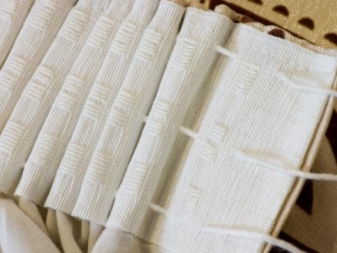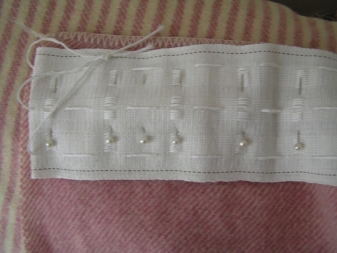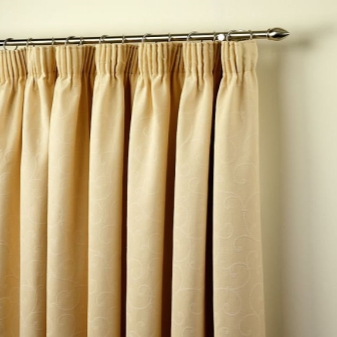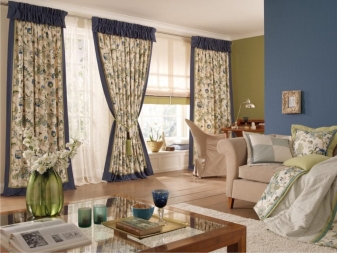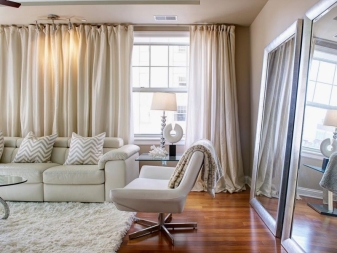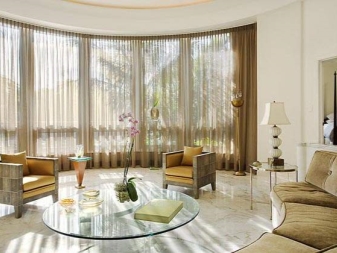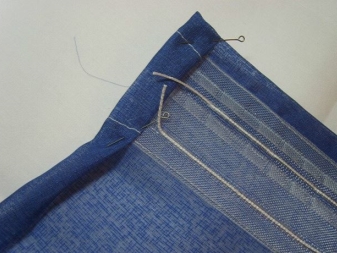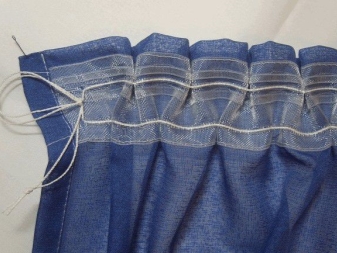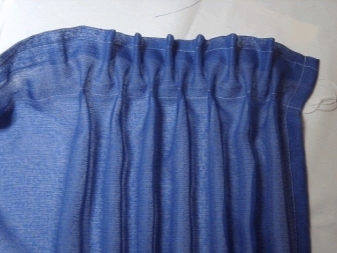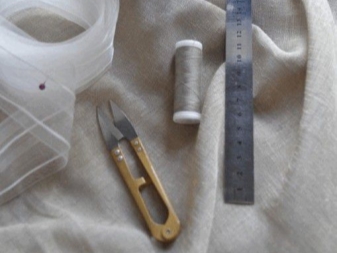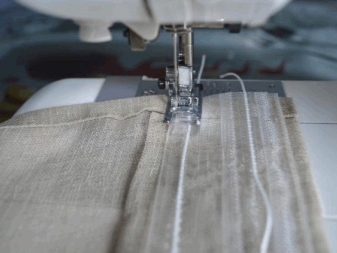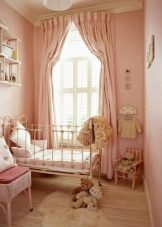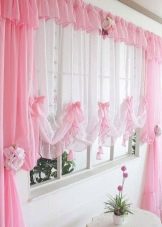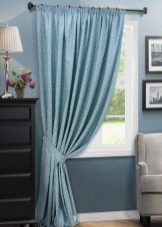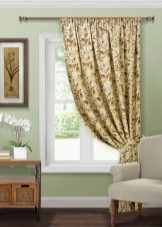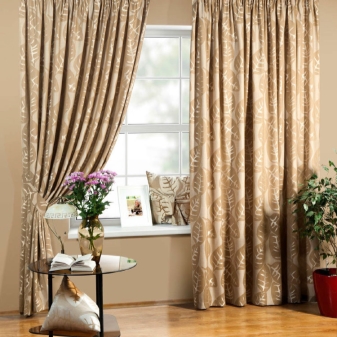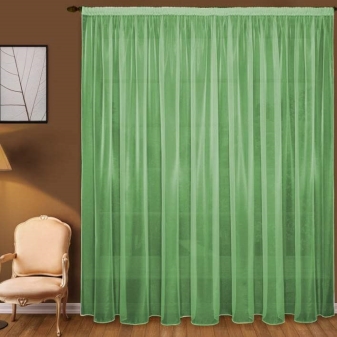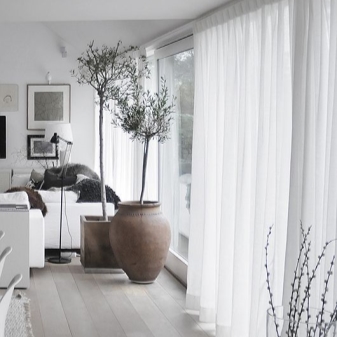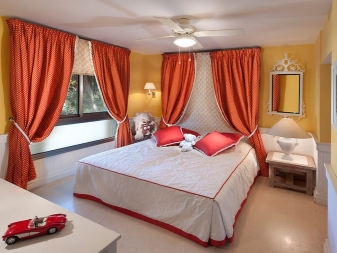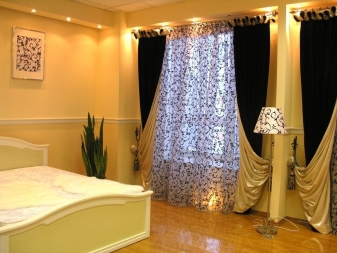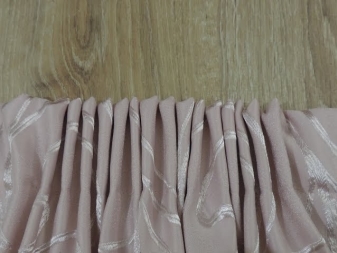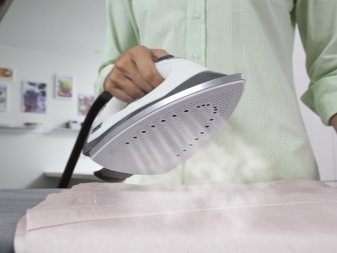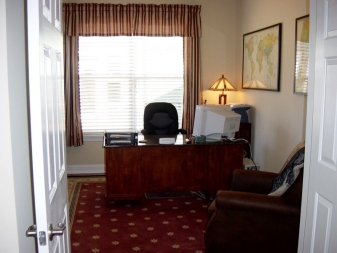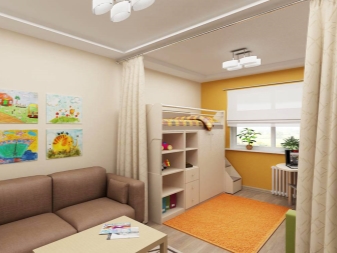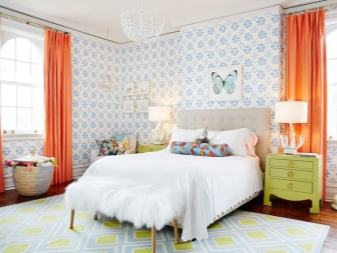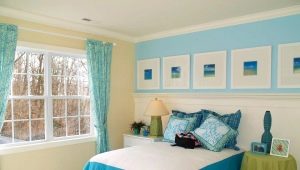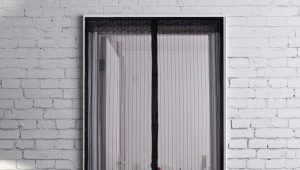How to use curtain tapes?
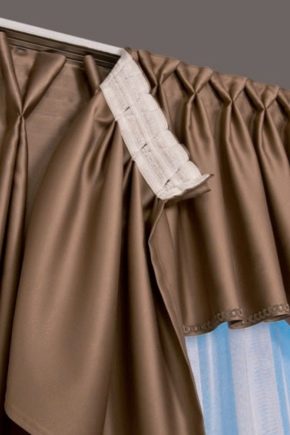
How to use curtain tapes is a logical question that arises immediately after the hostess learns what this device is. Indeed, at first glance it is not clear how using the translucent tape and ribbons you can get the original folds on the curtains, how to fasten it and what to do next. But it is worth a little to understand the topic, and beautifully drape the window is not difficult.
Special features
Curtain tape is a decorative soft hardware used to create folds of different widths and configurations on the fabric. Its use for decorating the window is very common lately among designers, needlewomen and craftsmen in sewing curtains, because this imperceptible detail even the most boring curtains can turn into elegant curtains.
The most convenient thing in it is that it is made not from stretching fabric, but from dense material, due to which it can be easily sewn on a typewriter to a fabric, and folds can be made of any density. Their size and quantity can be adjusted by several laces, passed through the entire length of the tape.
Curtain tape has the following features:
- Simplifies the process of sewing curtains;
- Does not require sewing loops to fix the fabric on the hooks - these loops are already provided on the tape;
- Allows you to drape a beautiful fabric of any density and texture;
- Allows original design of the window;
- It makes it possible to adjust the width and length of the curtains, without resorting to radical methods of cutting and filing fabric;
- Variable width - from 3-4 centimeters to 15-16;
- Even a transparent tape is made of durable material that does not crumble and does not lose shape;
- Fittings do not fade and do not deteriorate over time;
- To be washed in any mode, does not shrink;
- Easily tightened with cords;
- High-quality assembly gives clear and neat folds.
Kinds
There are several parameters by which the curtain tape is divided into types: the density of the material, width, type of attachment, method of draping fabric.
According to the density of the material, they emit: a transparent tape for light fabrics (organza, tulle, veil, mesh), opaque for heavier materials.
Nylon tape is used to preserve the aesthetic appearance of curtains. However, it should be borne in mind that the process of sewing invisible tape requires some skills, perseverance and time, and there are almost no loops under the hooks on it.
Cotton ribbon is used in cases where you do not need to try to hide it from prying eyes. It is much more convenient for sewing, even an amateur seamstress can cope with it in a fairly quick time. It also has its own characteristics - cotton can shrink up to 15% after the first wash. Considering this, before flashing, the tape must be either washed and dried, or carefully steamed with an iron.
The width is divided into narrow, medium and wide ribbons. This option is not chosen at random, but in accordance with the location and type of the eaves and the intended result.
The minimum width is intended for cases where:
- The eaves belong to the closed type, that is the junction of hooks with top of a curtain is behind the decorative level;
- The eaves are located in a niche;
- The upper part of the curtain instead of the decorative strip hides another element, for example, a pelmet.
The wide tape is recommended to be used in cases if:
- The cornice is open or has a non-standard shape:
- On the curtain there is a small number of hooks or fasteners. This can lead to sagging of the fabric on a thin ribbon, and the wide one will successfully support the top of the curtain without sagging;
- The folds at the top of the curtains are the main decoration.
The types of tapes for curtains according to the type of fastening are more variable, according to the method of fastening (attached and heat-adhesive) and according to the method of fixation on the eaves (with hooks, eyelets and velcro):
- Tape with hook loops. It is a soft accessories for the formation of folds, along the top or middle line of which there is a series of solid loops for hanging the curtain hooks. If the loops are 1-2 rows, they are intended only for hanging curtains, and 4 rows and more make it possible to adjust the height of the curtains without bending and hemming;
- Eyeglass or with mounting on grommets. This is a kind of tape with metal rings for pipe cornices of different diameters. Rings are simply strung on the curtain, and folds are formed by hand.Another variation is a tape with a longitudinal transparent pocket in the center, through which the curtain bar passes through;
- Velcro tape or crisc tape. For fixing it has a wide sticky strip, similar to velcro on clothes;
- Self adhesive This is a rigid curtain tape, on top of which is an adhesive strip for fastening;
- Combined. Tape combining several mounting options. Most often it is a loop and velcro;
- Thermoglue. Fastening occurs by heating the adhesive strip with an iron. It works the same way as stripes on clothes on a glue base: when heated under the influence of high temperature, the composition becomes liquid and glues the tape to the curtain, and then cools again, reliably connecting two layers of fabric to each other. There are several types: with one strip along the top edge, with stripes along the top and bottom edges at the same time for better fixation.
- For string cornice. The stringed cornice is similar to the pipe one, but its diameter is much smaller - this is a thin metal wire stretched over the curtain.
It is possible to fasten the curtain tape on the stringed eaves with the help of loops, velcro, eyelets, hooks.
Drapery
The most important characteristic of the curtain tape is the type of folds it gives. They are very diverse and look different on curtains depending on the density of the fabric.
The following types of drapery are popular:
- Bars. These are uniform rows of perfectly neat folds. Their number and degree of density depends on how much to pull the laces on the tape;
- Puffs. In contrast to the columns, it gives the opposite effect - uneven folds. When assembled it resembles a “waffle” surface, therefore “waffle” is the second name for this type of drapery;
- Pencil. Classic narrow repetitive folds. The easiest, fastest and versatile fold;
- Glasses (glasses, glasses). Got their name for the characteristic appearance of the folds, which resembles an elegant narrow and elongated glass on the leg. The width of the “glass” depends on how tightly the folds are collected. They look the most volumetric of all available;
- Bows. Forms neat laconic bows on the fabric. Beautiful, unusual, and done with just a couple of hand movements;
- Butterfly. Diamond-shaped folds formed by four cords on the tape;
- Cross folds. The overlapping creases are formed with the help of two tucks, which overlap each other.
- Fan, or the so-called French assembly. When the ribbon is woven, elegant folds in the shape of a fan of 4-5 feathers are formed.
The assembly process is not complicated in itself, but requires compliance with some nuances.
Pull the laces need to gently, it is desirable to do it simultaneously on both sides. With a large width of curtains or tulle, it will be easier to do it together.
If there is no assistant, one side must be fixed with improvised means and assembled one by one. The final step is a uniform distribution of the folds at the same distance from each other.
At first, it is difficult to do "by eye", but a centimeter tape will help out here. Measuring the total length of the curtain, it must be divided by the number of folds, then you get the same distance between the folds and the cornice will get a neat appearance.
In the process of pulling cords, they are extended quite strongly. In order not to confuse them with each other, especially in the amount of 3-4 pieces, you should use a paper sleeve for winding or special plastic clamps, which are sold in many departments with accessories and textiles.
A very common mistake with hanging hooks. It often happens that after assembling, they are not hung on the loops, which are intended for this purpose, but on the stretched cord that forms the pattern on the fabric. It is not right. When placing the hooks in this way, the curtains will sag under their own weight, and the beautiful folds will twist.
It is important to consider such an indicator as the “coefficient of assembly” of curtains and tape. This value is the ratio of the dimensions of the curtains and curtain tape, which determines the initial length of the tape before assembly. It is individual for each type of drapery:
- pencil - 2-3,5;
- bows - 2.5-3;
- puffs - 1.5-2.5;
- fan -2.5;
- glasses - 2-3;
- Grommets - 1.6-2.5.
These values are not final, they can be reduced or increased to unity depending on the desired density of the folds. The length of the tape, taking into account the coefficient, is calculated by the formula: the length of the cornices x assembly factor + 10 centimeters for bending the tape along the edges. That is, for example, if the length of the eaves is 3 meters, and a coefficient of 2.5 after an increase in the hem, you will get 7.6 m of curtain tape.
How to choose?
Correctly selected braid for the assembly - the key to excellent results. There are several basic criteria by which you need to choose the appropriate band:
- Type of cornice. For curtain rods located in a niche or under a decorative strip, a tape of medium width (about 6 centimeters) will suffice, since the hooks will still not be visible on the front side. For open-type cornices, a wide cotton ribbon with additional rows of loops is more suitable. Fasteners also will not be visible "from the face" of the product;
- Type of mount. The tape should correspond to the fastening possibilities on the eaves: on hooks, eyelets, velcro. Velcro Velcro is otherwise called a contact tape, which consists of two halves: loop and hook. For a string cornice absolutely any kind is convenient; grommets are more suitable for pipe eaves, for a eaves with hooks - a tape with loops; ceiling cornice is also convenient for different types of fastening;
- Curtain fabric. The material determines the degree of transparency of the webbing. To make the front side of the product of light translucent fabric look aesthetically pleasing, the curtain tape should also be chosen from translucent fabric. For more dense and heavy materials (for example, jacquard cloths) the accessories from dense cotton are intended;
- The design of the room. The general style direction determines the type of drapery and the degree of its complexity. For interiors designed in classical style, simple solutions are more like (pencil, counter creases), and historical styles are characterized by more original types, such as fans or glasses;
- Assembly factor The longer the cornice and the denser the fabric, the wider and stronger the tape should be. In that case, if you plan to place two curtains on one ribbon, you need to calculate the length of the ribbon for each separately, then add 10 cm and summarize the result;
- Additional decor. Simple pleated curtains will surprise no one. The last word in the design of the room - the use of lighting. It can be installed both on the tape and on the eaves to create additional volume on the play of light and shade and to increase the ceiling height visually. It is desirable that the backlight was LED, it will significantly save energy costs.
How to sew correctly?
The main advantage of the curtain tape is that it can be sewn at home if there is a sewing machine. Step-by-step instruction includes the following steps:
- The right choice of fabric and appropriate curtain tape.
- Processing curtains or tulle, depending on what was chosen for the combination with ribbon. This applies to those types of fabrics that have a crumbling, non-factory bottom or side edge. In this case, it must be treated with a double-hem seam. For ready-made curtains, which only need to sew tape, no manipulation is required.
- In the third stage, you need to sew between the tape and fabric. To do this, apply a curtain tape to the top edge of the curtain or tulle, to the front (this is important) side with the pockets down; bend inside the side edges of the tape. Then attach the tape with one line from the bottom for a width of up to 4 cm, and from 4 lines with two lines (an additional one is laid in the middle of the tape). All lines are stitched in one direction, not zigzag; the top edge is not stitched.
- At the next stage, you should bend the sewn strip of fabric with a 0.5 cm allowance to the seamy side. Thus, it will be in the right place in the right position, with pockets on top, so that it is convenient to put the cloth on the hooks in the future. Gently straightening the fabric to match the edges, you can pin up with pins and stitch the bottom line.This method of sewing eliminates the need to pre-process the upper edge of the fabric.
- The curtain is ready, it remains only to pull the laces to form the folds, distribute them through equal distances and attach the hooks (if the type of fastening means). The side pockets with this method are not stitched, so they can be attached to the laces in the tape.
Second way also begins with the choice of fabric and processing the edges of the product. Next, the upper edge of the curtain or tulle should be bent to the wrong side to the width of the curtain tape plus 0.5 cm. Before sewing the tape, it is bent at both edges 2 cm inwards, after releasing the laces. Attaching the tape close to the side edge you need to make a quick-look and then stitch on a typewriter.
This method also does not take much time, but on the front side of the product 2 or 3 seams will be visible instead of one.
The third way:
- Bend the upper edge of the fabric to the width of the curtain tape.
- On the hem, put the curtain tape with the pockets upwards, departing from the top edge of 0.5-1 cm. At the same time, the tape should be 3-4 cm shorter than the fabric at the edges (depending on the width of the double fold, 2x2 or 1.5x1.5 cm).
- Lay the wig with contrasting threads.
- Pave machine line. All seams should start from one edge.
- To process a side cut with double hem to the base of the tape so that the cords for the assembly walk freely and are not attached to the fabric.
With this method, the side hem is obtained as accurate as possible, as if the curtain was purchased immediately along with the tape.
How to calculate the length?
Sometimes even one extra centimeter of curtains can ruin the neat look of the window. But it is still possible to shorten the curtain - hang the eaves a little higher or trim the excess and hem with a sewing machine, but to make it longer is a very difficult task. So that you do not have to find different ways of transforming unusable curtains, you need to immediately and accurately perform all the calculations.
It is important to note that for measurements it is better to use not a soft measuring tape, but a building tape measure. It is longer and gives a more accurate result due to its rigidity.
There are three types of curtains: to the window sill, below the window sill and to the floor. The measurements are performed in the same way: from the base of the rings (hooks, clips) or rail on the eaves to the estimated length from the floor level.At the same time, extra centimeters for allowances are not included in this length. They are added when calculating the consumption of fabric: 3-4 centimeters from the bottom on a double bend, 0.5 cm, 1 cm or 1 cm plus the width of the curtain tape on top, depending on the type, which is supposed to sew the curtain to the tape.
The width of the fabric is determined by the length of the eaves (not the window opening, because the eaves protrude by 10-15 cm behind it) multiplied by the assembly factor. Plus 10 cm according to the formula for processing the edge and the absence of gaps on the sides.
For example, for a standard window with a cornice width of 200 cm and a height of 260 cm with a factor of 2 after all calculations, including bends, you will need 285 cm of fabric in height and 400 cm in width.
What to replace?
The curtain tape belongs to the category of those things which carry out very important function, and cost at the same time copecks. The need to find an alternative that can be used instead of these accessories, arises only in the case when the store simply did not find a suitable option. There are two solutions to the problem depending on the type of attachment:
- For hooks and crocodiles. Sew the ribbon by yourself, using a very thick “Iris” thread as the laces or calculate the assembly factor and fold the folds manually.
- For pipe eaves. It is convenient to hang a curtain on a pipe on a tape, which has wide loops or a solid pocket. It is quite difficult to sew a tape with grommets on its own, but it’s easy to stitch one longitudinal pocket along the pipe diameter even for a beginning seamstress.
Care
To properly use the ribbon for curtains, it is important to consider only a few features:
- Lay all the lines in one direction so that the product does not warp;
- To form folds, tightening the laces at the same time on both sides;
- Pre-wash or steam the tape so that it does not shrink after the first wash.
- If the product quality, suitable hand and machine wash. It is necessary to focus on the choice of temperature and detergent according to the type of material from which the curtain or tulle is sewn.
Examples in the interior
The folds on the curtains are universal. A classic pencil assembly on neutral monochromatic fabric to the window sill is suitable for a municipal organization or office, original fans or glasses on curtains to the floor will be appropriate in the living room in a historical style, light puffs on blackout curtains will perfectly complement the bedroom, and bright curtains with bows will make a children's room.
For information on how to choose the right curtain tape, see the following video.
